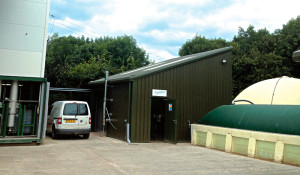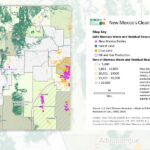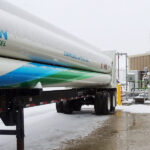BioCycle August 2014
Washington, DC: Most Digester RNG Classified As Cellulosic In RFS Rulemaking
Producers of renewable natural gas (RNG) were all smiles after the U.S. EPA announced the final rule for the second phase of its Renewable Fuels Standard (RFS). The changes are “above and beyond what we were hoping for,” says David Cox, director of operations at the Coalition for Renewable Natural Gas, the main industry advocacy group. It’s a “great development for the biogas industry,” notes Harrison Clay, president of Clean Energy Renewable Fuels, in California.
The boost comes from two decisions: First, the EPA said most types of RNG would now be classified as cellulosic ethanol. And, in an unexpected move, it said the RFS would now include RNG utilized to generate electricity for electric vehicles. RNG, produced by removing impurities from landfill and digester biogas, is identical to petroleum-based natural gas but with a far lower carbon footprint. Particularly as a transportation fuel, it’s an increasingly attractive alternative to electricity generation from raw biogas, as that market stagnates.
The RFS was created under the 2005 Energy Policy Act to increase the volume of renewable fuels that are blended into transportation fuels. It requires “any party that produces gasoline for use in the United States” to buy minimum annual volumes of renewables. It also creates a complex system, based on a trade in Renewable Identification Numbers, or RINs, to establish the price. The new final rule establishes standards up to 2022. The system classifies the alternatives fuels into four categories or pathways, each assigned its own minimum volume, based, in large part, on the amount of each renewable fuel that will be available and potential demand. They include renewable fuel, cellulosic biofuel, advanced biofuel, and biodiesel. Renewable fuel, the largest category, covers conventional ethanol, made from corn, sugar and other easily processed starches. Cellulosic biofuel includes so-called second-generation ethanol, made from corn stover and other fibrous crop residues, wood chips and grasses grown specifically for ethanol production. Production has been far below its minimum volume since no one yet knows how to make the fuel on a reasonably priced commercial scale. The shortfall had prompted the EPA to propose a drastically reduced minimum volume.
In the original version of the standard, RNG was classified as an advanced biofuel, with a very small minimum volume that the industry argued was far below potential production. The new version moves most forms of RNG — all except those mainly from the anaerobic digestion of food wastes composed of starches and sugar, and with low cellulose content — into the cellulosic biofuel category, with a steadily increasing minimum volume. Exact production and price impacts won’t be known until next month, when EPA announces the final detailed volume requirements for this year. “The change will put RNG in higher demand,” Cox says. That, in turn, is expected to boost the value of its RINs. He adds that while the category shift will impact the market right away, the decision to support RNG used to power EVs could eventually prove more significant: “In the long term, it’s a really big deal.”

Barrett’s Mill Anaerobic Digester (BMAD) facility in Shropshire, England, built by Evergreen Gas in 2012.
Shropshire, England: Barrett’s Mill Anaerobic Digester
The Barrett’s Mill Anaerobic Digester (BMAD) facility was built by Evergreen Gas in 2012. Evergreen, based in Shropshire, specializes in designing, building and optimizing AD systems, especially those under 250 kWh. The BMAD facility receives about 4 tons/week of poultry litter from a local farm and grass clippings from the property where it is located. The 49 cubic meter (m3) mesophilic digester was designed to accept food waste so there is a covered reception area that is required by law. Moisture content during digestion is 12 to 13 percent.
The digester is partially buried, about 10-feet below ground and 3-feet above, which reduces its visual impact. The biogas goes through a biogas to fuel (BfT) upgrader with a capacity of 30 m3/hour. (Evergreen is the UK vendor of this BtF system, which is made by Metener Ltd., a Finnish company.) Roughly 650 lbs/day of feedstock creates 10 m3 of biogas/hour. Each cubic meter is the equivalent of 2 kWh. Biogas is cleaned using two absorption columns. The biogas is 92 to 95 percent pure methane when it is compressed into vehicle fuel. A chiller reduces the temperature to 8°C (46°F). One kilo of gas is roughly equivalent to 1 liter of gasoline (0.26 gal); enough biogas is produced to fuel one of Evergreen’s biogas-powered vans 900 mile/day (the company has two vans in its fleet).
Digested organics are reduced by about 70 percent by weight, and separated into solid and liquid fractions. The solids contain 25 to 35 percent dry matter and are used as a soil amendment on the property and for fertilizer and animal bedding at local farms.
Washington, DC: Biogas Opportunities Roadmap Released
The Biogas Opportunities Roadmap: Voluntary Actions to Reduce Methane Emissions and Increase Energy Independence was released on August 1, highlighting the economic and environmental benefits that can result from constructing more biogas systems to recycle organic materials. The Biogas Roadmap, a part of the Obama administration’s Strategy to Reduce Methane Emissions, culminates a cross-agency collaboration between the U.S. Departments of Agriculture and Energy and the U.S. EPA. Included in the Roadmap are commitments from the federal agencies to foster investment in biogas systems; strengthen markets for the systems and system products; and improve communication and coordination. An article with more details on the Biogas Roadmap will be in the September issue of BioCycle. Visit www.epa.gov/agstar to download the Roadmap.
Perris, California: Construction Underway At MSW Organics Digester
CR&R Environmental Services began construction of its anaerobic digestion facility in Perris. The project’s first phase will convert over 80,000 tons/year of municipal organics — primarily yard trimmings and food scraps — into renewable natural gas (RNG). The facility is fully permitted for three additional phases that ultimately will convert over 320,000 tons of organics into RNG and generate the energy equivalent of 4 million diesel gallons. CR&R is using the Eisenmann high solids anaerobic digestion system that employs a continuously fed, horizontal plug flow design. Source separated material will go through a proprietary sorting process to provide conditioned organic material to load into the digester. Greenlane Biogas is supplying the gas clean-up and compression system. The RNG produced in Phase 1 will be used in about 70 of the company’s natural gas collection vehicles. Subsequent phases will enable CR&R to inject RNG into the Southern California Gas pipeline.
“After five years of careful planning it’s nice to see the steel finally coming out of the ground,” says Mike Silva, Civil Engineer and Project Manager for CR&R. He anticipates completion of Phase 1 in the first quarter of 2015.












